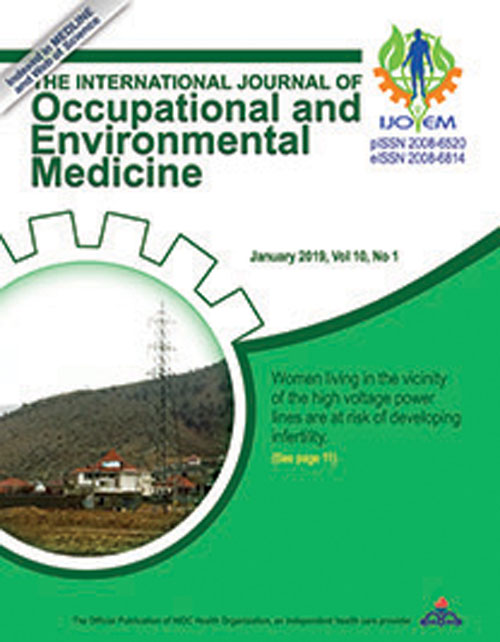فهرست مطالب

International Journal of Occupational and Environmental Medicine
Volume:10 Issue: 1, Jan 2019
- تاریخ انتشار: 1397/11/17
- تعداد عناوین: 7
-
-
Pages 1-10BackgroundChildhood overweight and obesity is a major health problem in many low- and middle-income countries such as Nepal. There is evidence indicating a significant association between health and access to green space.ObjectiveTo estimate the prevalence of childhood overweight and obesity, and to identify its association with green space among primary school children in Kathmandu metropolitan city, Nepal.MethodsA cross-sectional study was conducted on 440 (195 male and 245 female) students studying in selected primary schools of Kathmandu metropolitan city. Mothers/caretakers of the participating children were also studied.ResultsOf the 440 children, 13.2% were overweight; 6.8% were obese. 4 of 16 studied variables that had significant associations with overweight/obesity in bivariate analyses, were found independent predictors of overweight/obesity after being adjusted for confounders. They included mode of transportation to school (aOR 2.08, 95% CI 1.12 to 3.88), consumption of sugary snack (aOR 2.57, 95% CI 1.12 to 5.91) and salty/savory snack (aOR 4.13, 95% CI 1.71 to 9.96), and the distance of a green space from child's residence (aOR 27.46, 95% CI 6.10 to 123.54).ConclusionOne-fifth of the children in urban schools were found to be overweight or obese. The distance to a green space was identified as the most significant factor influencing childhood overweight/obesity.Keywords: Overweight, Obesity, Green space, Child, Chronic disease, Nepal, Health
-
Pages 11-16BackgroundLiving in the vicinity of high voltage power lines has brought about a range of health woes, but the effect of residential exposure to electromagnetic fields from the power lines on female fertility has not been explored yet.ObjectiveTo test the hypothesis if residential proximity to high voltage power lines could be associated with the increased risk of female infertility.MethodsIn a case-control study, 462 women with confirmed diagnosis of unexplained infertility or behavioral and environmental factors were assessed between February 2014 and December 2016. Control group comprised of 471 persons with no history of infertility selected using randomized-digit dialing from the numbers registered in a birth registry between 2014 and 2016. The nearest linear distance from high voltage power lines to the participants' residence of cases and controls was measured using a Geographical Information System (GIS) and Google Earth aerial evaluation for high voltage power lines (240–400 kV).Results112 (14.1%) houses were within 500 meters from a high voltage power line. Women living within 500 meters of the lines (OR 4.14, 95% CI 2.61 to 6.57) and 500–1000 meters of the line (OR 1.61, 95% CI 1.05 to 2.47) carried a significantly higher risk of infertility than those women living more than 1000 meters away from the power lines. After adjusting for confounding factors, women living within 500 meters of the lines carried a higher risk (aOR 4.44, 95% CI 2.77 to 7.11) of infertility compared with women living more than 1000 meters of the lines.ConclusionThe current safety guidelines for electromagnetic fields exposure seems to be not adequate for protecting people from the hazardous effects of the field.Keywords: Reproductive health, Environment, Risk assessment, Risk factors, Electric power supplies, Geographic information systems
-
Pages 17-29BackgroundThe prevalence of growth disorders among school-aged children in Indonesia is high (30.7%). Pesticides have been massively used in Indonesian agricultural areas.ObjectiveTo determine if exposure to pesticides is associated with stunting among children in agricultural areas.MethodsThis case-control study included 160 children (48 cases and 112 controls) aged 8–12 years. Exposure to pesticides was measured based on the history of the exposure since perinatal period, infancy, and childhood of the participants. Stunting was determined as a height for age z-score (HAZ) < ‑2 SD. Other variables measured were levels of thyroid stimulating hormone (TSH), insulin-like growth factor-1 (IGF-1), hemoglobin, zinc, albumin, nutrient adequacy level (energy and protein), and history of infection, low-birth weight (LBW), and mother's height.ResultsThere were no significant difference between the cases and controls in terms of in the baseline characteristics, except for the median IGF-1 level; it was significantly (p<0.001) lower in the cases (66.73 ng/mL) than the controls (112.57 ng/mL). High level of pesticide exposure (p=0.029) and low IGF-1 levels (p<0.001) were significantly associated with stunting. After adjusting for confounding variables, these variables were found to be independent risk factors for stunting in children (aOR 3.90, 95% CI 1.15 to 13.26; and aOR 8.35, 95% CI 3.65 to 19.14, respectively).ConclusionPesticide exposure could be a risk factor for the occurrence of growth disorders in children living in agricultural areas. Necessary actions should be taken to protect children living in agricultural areas from exposure to pesticides.Keywords: Pesticides, Growth disorders, Child, Agriculture
-
Pages 30-39BackgroundHealth literacy has received growing attention in recent years to reduce health disparities. Health literate individuals can gain access, understand and use health information to maintain, improve and promote good health.ObjectiveTo develop and assess the psychometric properties of a tool for the measurement of health literacy among workers, the Health Literacy Scale for Workers (HELSW).Methods15 companies were selected from the factories of the industrial city of Saveh. 450 (400 male and 50 female) workers from Saveh, Iran, were selected through a multistage random sampling. The study had two stages—a qualitative and a quantitative stage. In the qualitative phase, the workers' beliefs were extracted based on 61 in-depth interviews. Content validity was assessed with the help of 12 experts in the field of health education, public health and occupational health. Also, face validity was evaluated through interviewing with 20 workers. In the quantitative phase, the reliability of the questionnaire was evaluated by measuring the internal consistency and test-retest reliability. The construct validity was assessed by the principal component analysis using varimax rotation.ResultsIn the exploratory factor analysis, six domains (ie, access, reading, understanding, assessment, decision making and applying health information, and self-efficacy) with 34 items were loaded; the model explained 64.3% of the total variance. Intraclass correlation coefficient and test-retest reliability ranged from 0.72 to 0.84 and 0.69 to 0.86, respectively.ConclusionIt seems that the developed Persian questionnaire, HELSW, is a reliable and valid measure of the health literacy in workers.Keywords: Health literacy, Reproducibility of results, Psychometrics, Surveys, questionnaires, Iran
-
Pages 40-49BackgroundWelding is a common industrial process and is harmful to welders' health.ObjectiveTo determine the effect of toxic gases and metal fumes produced during 3 welding processes on welders' incidence of respiratory symptoms and pulmonary function.MethodsThis cross-sectional study was conducted in an Iranian shipbuilding industrial factory in 2018. Using the simple census method, 60 welders were selected as the exposed group. 45 staff members of the administrative unit were also recruited to be served as the control group. Welders' demographic data and respiratory complaints were collected employing a questionnaire. Fumes and gases produced were sampled from the welders' respiratory tract and analyzed by standard methods suggested by the National Institute of Occupational Safety and Health (NIOSH). Pulmonary function test was also performed for each participant.ResultsThe prevalence of respiratory symptoms in all welders was significantly (p<0.05) higher than the control group. The mean FVC, FEV1 and FEV1/FVC measured in welders involved in all 3 processes were significantly lower than those recorded in the control group. The spirometry pattern in welders involved in flux cored arc welding and shielded metal arc welding was obstructive; that in those involved in gas metal arch welding was mixed (obstructive and restrictive pattern).ConclusionExposure to welding fumes and gases was associated with pulmonary function deterioration. Welders involved in gas metal arch welding had a higher prevalence of pulmonary disorders compared with those involved in gas metal arch welding and flux cored arc welding.Keywords: Welding, Respiratory function tests, Spirometry, Signs, symptoms, respiratory
-
Page 52


